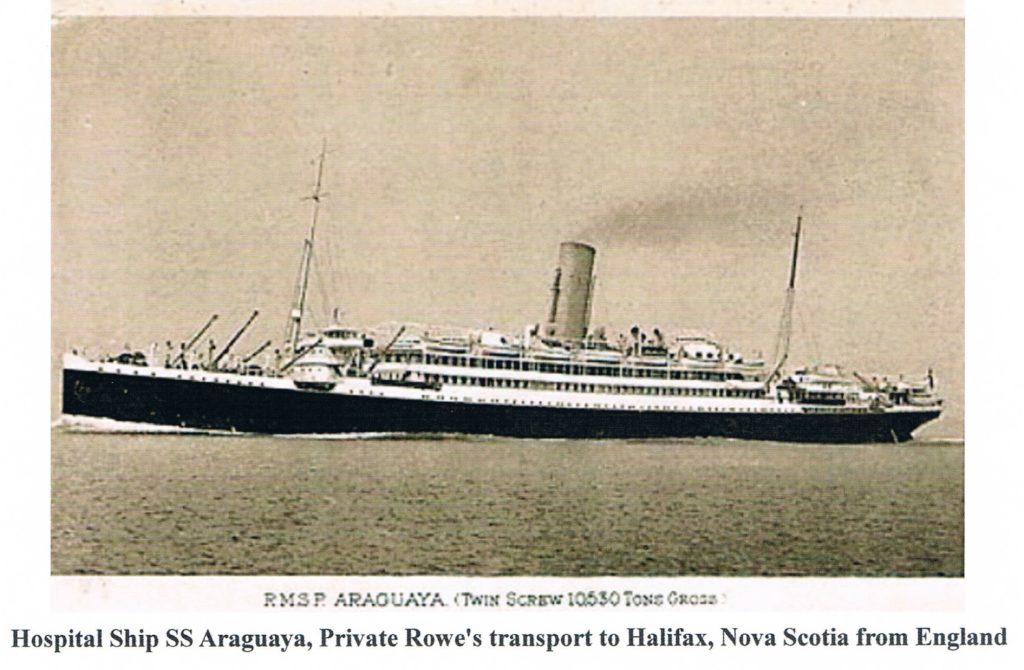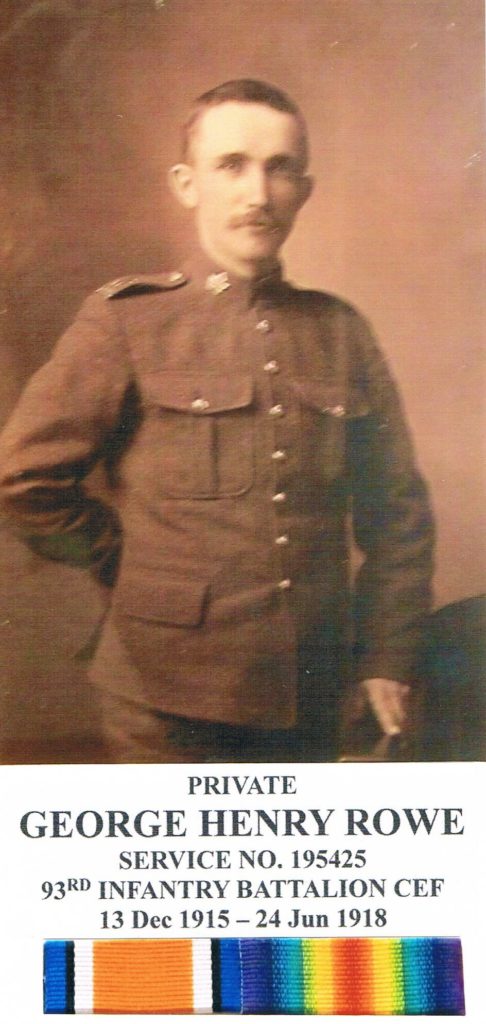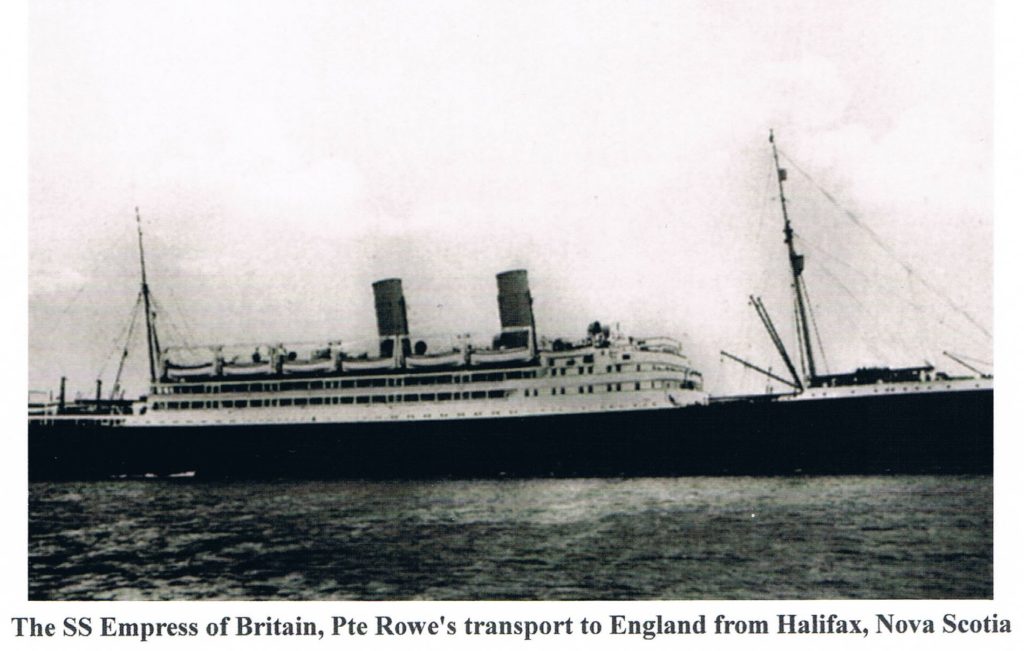MILITARY HISTORY
Private George Henry Rowe – 195425 – ACTIVE SERVICE (World War I)
On December 13, 1915 George Henry Rowe completed the Attestation Paper for the Canadian Army (Expeditionary Force). He was 35 years, 9 months and 27 days old when, as a married man, with two sons (Edwin Adrian 13 years and Sherman John 12 years), he enlisted for the duration of the War. George Henry Rowe was born in Lakefield, Ontario, and gave his birth-date as February 16, 1880. On his Attestation Paper, George Henry indicated “he did not presently belong to an Active Militia, and that he had never served in any Military Force”. There is nothing on his File to indicate where he was educated or to what level. As far as George Henry’s Trade or Calling is concerned, he lists Laborer. George Henry was 5′ 5¾” tall, with a 35” chest (expanded). His weight is listed as 110 pounds; he had a dark complexion, with gray eyes, and dark brown hair. George Henry’s Medical Records indicate that he had no medical issues or physical limitations and as such he was deemed fit for Overseas duty with the Canadian Expeditionary Force (CEF). His next-of-kin was listed as his wife, Mrs. Elizabeth May Rowe, of Lakefield, Ontario. George Henry Rowe signed the Oath and Certificate of Attestation on December 13, 1915 in Peterborough, Ontario. The Certificate of Magistrate was signed by the Justice on December 13, 1915. George Henry Rowe was taken-on-strength with the 57th Regiment (Peterborough) Canadian Expeditionary Force. He was assigned the rank of Private (Pte) and Regimental Number 195425. When the 93rd Bn (Peterborough) was authorized and formed up on December 22, 1915 Pte Rowe was struck-off-strength from the 57th Regiment and taken-on-strength with this new Unit (93rd Bn).
The 93rd Bn, after training in Peterborough and area throughout the Winter and Spring, departed by train from Peterborough on May 29, 1916. The 93rd Bn made a short stop at Barriefield Camp, located at Kingston, Ontario, before moving on to the CEF’s main Training Centre located at Valcartier, Québec so as to complete Basic and Advanced Infantry training before being transported overseas to the UK. The 93rd Bn embarked from Halifax, Nova Scotia on July 15, 1916 aboard the SS Empress of Britain.
Pte Rowe disembarked in Liverpool, England on July 25, 1916. He would have been doing extensive training and duties in England with the 93rd Bn for about 3 months before being transferred to the 52nd Bn. On October 4, 1916, Pte Rowe was struck-off-strength from the 93rd Bn on transfer to the 52nd Battalion stationed at Otterford, England. On October 5, 1916, he landed in France and was taken-on-strength with the 52nd Battalion in the Field. On October 15, 1916 he left to join his Unit; Pte Rowe arrived at the 52nd Bn for duty which was in a Reserve position on October 20, 1916.
According to the 52nd Canadian Battalion War Diary – the 52nd Bn moved forward from its Reserve position and relieved the 2/14 British Battalion, London Regiment (LR) on the Front-Line the night of October 25, 1916. The 52nd Bn was stationed on the right flank of Vimy Ridge, in the Arras District. It was in turn relieved on October 31, 1916. There are no specific references, in the War Diaries, indicating engagements with the Germans during this period.
On October 27, 1916, Pte Rowe was reported as being ”dangerously wounded”. October 28, 1916, it was reported that Pte Rowe had a shrapnel wound to his head. On October 31, 1916, Pte Rowe is listed as ”dangerously wounded”. The File indicates he suffered a GSW (gunshot wound) to the back of the head. Another report indicates he was wounded after ”being hit in the head by an explosive shell”. He also had a slight wound to his right hip.
On October 29, 1916, Pte Rowe ”regained consciousness for a time” and was treated at the No 30 Casualty Clearing Station (CCS). October 31, 1916 he was transferred to the No 8 General Hospital, at Wimereux, France where he received further treatment. November 9, 1916 an Assessment was conducted. It states in part: ”no operation performed at this Hospital. Wound rather dirty on admission. Patient was rendered unconscious when injured. Had a helmet on at the time. Reactions and reflexes dull. Has suffered a good deal from headaches. No vomiting since admittance”. Pte Rowe was ”deemed fit to travel” and as such he was evacuated to England.
On November 11, 1916 it was indicated that the left parietal area was where the wound was located. Pte Rowe was transferred to the Canadian Casualty Assessment Centre located at Shoreham, England.
November 12, 1916 Pte Rowe was transferred to the King George Hospital on Stamford Street, London, England. Upon admittance an Assessment of his condition was conducted. The File states: ”Wounded by Shrapnel in France Oct 29, 1916. The foreign body (FB) caused a (unreadable) wound of the scalp over the left Parietal Bone. Scalp wound was explored at No 30 CCS Oct 30, 1916. Nothing was found and wound sutured. (unreadable) shows a fracture of left Parietal Bone”. Another note indicates: ”wound still discharging, dressing being changed daily”. A note dated December 3, 1916 states: ”doing very well”.
On February 3, 1917, Pte Rowe was admitted to the Ontario Military Hospital at Orpington, England. At this point he was complaining of ”pains in his head”. February 10, 1917 complains of ”peculiar feeling in head”. February 20, 1917 X-ray done on his head; the X-ray shows no fracture of the skull, but presence of a small piece of shrapnel in the temporal region.
March 1, 1917 he was admitted to the Canadian Convalescent Military Hospital at Woodcote Park, Epsom, England. His symptoms had now increased. He was experiencing; constant headaches, vertigo, dizziness, difficulty walking, poor memory, sleeplessness, shortness of breath, and deafness. A note was made indicating the wound had healed well. A Medical Officer summed up his condition as follows: Does he need Hospital treatment – no. Will he be fit of Overseas – probably not. Prognosis – very poor.
March 10, 1917 Pte Rowe was struck-off-strength from the Canadian Casualty Assembly Centre (CCAC), at Folkestone, England on transfer to Manitoba Regiment stationed at Hastings, England.
March 17, 1917 Pte Rowe was back at the Ontario Military Hospital where he was placed in an Isolation Ward due to having been in contact with measles. He was discharged from the Ontario Military Hospital on June 11, 1917 and embarked from Liverpool for Canada aboard the Hospital Ship – SS Araguaya.
 The following Notes were made during the voyage: ”June 12, 1917 showed some mental symptoms. moroseness & irritability. When ordered to put on a life-belt for boat drill, he refused because he had perceived no orders from the Captain of the ship. On inquiry it was ascertained that he had previously shown signs of mental trouble as witnessed by other patients. He was transferred to the Mental Ward”. ”June 18, 1917, he has been quiet since being transferred to Mental Ward, but appears depressed. Taken his usual turns of exercise. Gives no trouble with his food”. ”June 21, 1917 condition same”.
The following Notes were made during the voyage: ”June 12, 1917 showed some mental symptoms. moroseness & irritability. When ordered to put on a life-belt for boat drill, he refused because he had perceived no orders from the Captain of the ship. On inquiry it was ascertained that he had previously shown signs of mental trouble as witnessed by other patients. He was transferred to the Mental Ward”. ”June 18, 1917, he has been quiet since being transferred to Mental Ward, but appears depressed. Taken his usual turns of exercise. Gives no trouble with his food”. ”June 21, 1917 condition same”.
On arrival in Canada on June 25, 1917 another Assessment was conducted of Pte Rowe. This one states: ”Cause of disability – mental trouble”. ”He says that 3 months ago after being wounded on the back of the head, he began to feel headaches – deafness – vertigo. Present condition – heart and lungs normal, general condition fair – it is very hard to get information from him, he seems to have lost his memory – there is a healed wound on the left side of the left Parietal bone – 1 inch long, the result of a fracture of the (unreadable) bone. He is very nervous and shows signs of mental trouble. This man should be sent for observation by Specialists. ”Recommendation send to Cobourg for observation and treatment”. June 27, 1917 Pte Rowe was admitted to the Cobourg Military Hospital located in Cobourg, Ontario.
September 4, 1917 Pte Rowe was transferred to the Newmarket Military Hospital, he is diagnosed as: ”Catatonic Dementia Parecox”. ”Very negativistic. Has improved greatly here, still requires Custodial Care”. December 11, 1917 another Assessment was conducted by a Medical Officer, the results were, in part: History – scar on left side of head from gunshot wound received October 28, 1916. After being wounded he was returned to England and his present mental condition developed insidiously. Present condition – ”patient is quite confused, absolutely disorientated as to time and place, oblivious to his surroundings. He is unclean in his habits and untidy in his dress. He exhibits many and varied unfixed delusions. The condition is deemed permanent. Patient must necessarily be maintained and cared for in a Hospital for the Insane”. ”Recommendation is that this Patient be discharged from the Army, and arrangements be made for his maintenance in one or other of the Provincial Hospitals for the care of the Insane”. On December 12, 1917, the Medical Board of Newmarket Military Hospital concurred with the recommendation stating: ”It is recommended that this soldier be discharged from the Army and as his case is evidently one in which Dementia is so far advance that recovery cannot be expected, that arrangements be made for his care in one or other of the provincial Hospitals for the treatment of the Insane. This soldier is permanently and incurably insane, and as stated, arrangements should be made for his maintenance in an Ontario Hospital, the nearest Hospital to his home would be Mimico, Ontario”.
December 18, 1917 Pte Rowe was admitted to the Mimico Asylum, located at Mimico, Ontario.
On June 18, 1918 Pte Rowe was discharged from the Canadian Expeditionary Force due to ”physical unfitness”. His address at time of Discharge is shown as Mimico Asylum, Mimico, Ontario. Based on his inability to sign the Discharge Certificate another individual signed on his behalf. The Discharge Certificate was signed at Toronto, Ontario June 24, 1918 in Military District No 2.
There is no reference in Pte George Henry Rowe’s Military File, indicating what Military Medals he was awarded but based on his Military Service, he should have received:
British War Medal 1914 – 1920; and
Victory Medal.
He also qualified for War Service Badge CEF Class “B”.
Based on his Military File, Pte Rowe served a total of 29 months and 27 days with the Canadian Expeditionary Force: 1 year and 7 months in Canada, 9 months 15 days in England, and 1 month 7 days in France. Most of this time was spent in convalescence.
George Henry Rowe would remain at Mimico Asylum until his passing May 18, 1953.
An excerpt from an article in Maclean’s by Barbara Ameil, September 1996:
The Military is the single calling in the world with job specifications that include a commitment to die for your nation. What could be more honorable.
PERSONAL HISTORY
GEORGE HENRY ROWE
George Henry Rowe was born February 16, 1880 in Lakefield, Peterborough County, Ontario, son of William Rowe and Emma Grace Jory. George Henry worked as a labourer; he was the eldest of 4 children, his mother was his father’s first wife who died at 26 years old on April 12, 1884 when George was only 4 years old.
On April 16, 1902 George Henry Rowe married Elizabeth “Lizzie” May Hurl in Peterborough. She was born April 29, 1885 in Harvey Township, daughter of William James Hurl and Margaret Curtin. They had two sons: Edwin Adrian, born November 6, 1902 and Sherman John, born January 1904. In the 1911 Census George was a labourer in cement, possibly working at the Portland Cement Company or for a Contractor.
On December 13, 1915 George enlisted in Peterborough to serve his King and Country. George served in England and France; however, on October 29, 1916, George was seriously wounded by a gunshot wound to the head. George was sent back to England where he was hospitalized at the King George Hospital in London for several months. At Christmas 1916, all the wounded veterans were visited by His Majesty King George V and presented with a Christmas card, a copy of the Soldiers’ Marching Songs booklet as well as a book called “The Queen’s Gift Book”. The sale of this book was to support the Queen Mary’s Convalescent Auxiliary Hospitals for Soldiers and Sailors who had lost their limbs in the war.
George was discharged on June 24, 1918 and sent home to Ontario, Canada. George did not know who he was nor did he know his family. George was transferred to the Mimico Asylum in Etobicoke, Ontario where he remained until his death on May 18, 1953; he is buried in Little Lake Cemetery in Peterborough, Ontario.
His wife, Elizabeth was left to raise their two sons on her own. She moved to Peterborough and took in boarders, did crotchet work, knitting and sewing, etc. to help support herself and the boys. Elizabeth “Lizzie” May died December 24, 1979 and is buried in Little Lake Cemetery.
THE GEORGE HENRY ROWE FAMILY OF DUMMER TOWNSHIP
George Henry’s paternal grandparents are George Rowe born in 1824 and Maria Kellow born in 1830. They resided in Lakefield and had a family of five children William, Elizabeth Jane, Annie Marie, George Henry and Thomas James Rowe. Maria passed away in 1903 and George died in 1906; both are buried in Lakefield Cemetery.
His maternal grandparents are John Jory born in 1806 and Margaret Ann “Annie” Hurl born in 1817. They resided in Lakefield and had five children Mary Jane, Samuel Nehemiah, Ann Elizabeth, Emma Grace and Edward John Jory. John passed away in 1887 and Annie died in 1889.
George Henry’s parents were William Rowe and Emma Grace Jory. William was born on July 24, 1854 in England and immigrated to Canada in 1862. Emma Grace Jory was born on August 10, 1858 in England and immigrated to Canada in 1872. They were married in Lakefield on April 23, 1879 and lived on Oxford Street near the end of Nicholls Street in Lakefield. They had four children George Henry, John Alexander, Bertha and Emma Grand Rowe. Sadly Emma Grace died nine days after giving birth to Emma Grand on April 12, 1884 and is buried in Lakefield Cemetery.
On October 5, 1887, William Rowe married Sarah Ann “Annie” Pearce in Lakefield. She was born on August 10, 1860 in England, daughter of James Pearce and Mary Ann Sparks. They had three children William “Oscar”, James “Howard” and Gertrude Edith. In 1911, the family was living on Albert Street beside John & Mary Millage and William was working at a saw mill. Sarah Ann “Annie” passed away on December 20, 1936 and William died on November 1, 1944; both are buried in Lakefield Cemetery.
George Henry Rowe was a member of the Lakefield Methodist church and is included on the Memorial Plaque which honours their members who served in the Armed forced during World War 1. The plaque currently hangs in the sanctuary of the Lakefield United Church 47 Regent Street, Lakefield Ontario.


